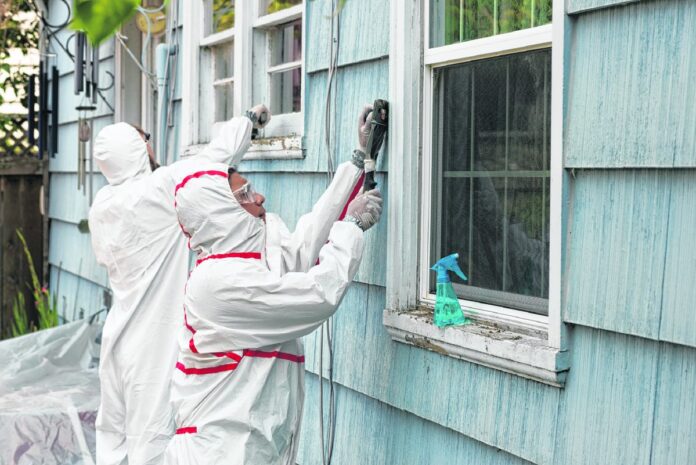
Bartholomew County health officials are stepping up efforts to have more children tested for lead — a toxic metal linked to numerous developmental difficulties and neurological damage.
Only around 10 percent of children in the county age 6 or younger are tested for lead, according to county health officials.
The federal threshold currently is 5 micrograms per deciliter of blood, or the equivalent of five-millionths (0.000005) of one gram in one-tenth of a liter of blood.
“We’re just trying to get the information out (about lead) because lead is here, and it’s been here for dozens of years,” said Mary Shaffer, lead case manager at the Bartholomew County Health Department.
[sc:text-divider text-divider-title=”Story continues below gallery” ]
The Indiana State Department of Health tracks the potential risk for lead exposure across the state based on the prevalence of certain risk factors, including the age of homes in a given area and childhood poverty.
One particular area of Bartholomew County was deemed by the state to have a higher potential risk for lead exposure than many places in the state, including higher than a sector of East Chicago that was the site of that city’s lead crisis in 2016.
The 1.9-square-mile area of the county, known as Census Tract 101, largely comprises the Lincoln-Central Neighborhood in central Columbus. The area includes downtown Columbus, runs along Hawcreek Boulevard to the east and the East Fork of the White River to the west and weaves across the city from east to west along 16th Street and 17th Street.
The area of Columbus was given a lead risk rating of 50.6 because approximately 90.9 percent of the homes in the area were built before 1960 and 33.2 percent of children ages 6 years and younger in the area live below the federal poverty line. The poverty data was based on the 2010 U.S. Census. The area of East Chicago received a rating of 48.4, with 74.5 percent of homes built before 1960 and nearly 80 percent of children living in poverty.
The state’s rating does not indicate that there is higher incidence of lead in central Columbus than East Chicago, nor does it not consider the allegation that East Chicago officials allowed housing there to be built directly on top of the former site of a lead smelter and metal processing plant that, as it turned out, had not been properly cleaned up, according to news accounts.
Grant to fund lead screenings
The county recently secured a $10,000 grant from the Indiana State Department of Health to increase the number of children screened for lead and provide ongoing technical education to local healthcare providers and to the public.
Lead is a naturally occurring metal found in the Earth’s crust that was commonly used in the production of certain paints, plumbing components, consumer products and other items until the last quarter of the 20th century.
Even though federal efforts to reduce lead exposure in recent decades has reduced the number of children with elevated blood lead levels in the United States from 14.8 million in 1978 to around 500,000 today, cases of elevated blood lead levels in children continue to be found in scores of communities across the country, including Bartholomew County.
From 2014 to 2018, 80 blood lead level screenings among children 6 years old and younger in Bartholomew County — including 14 last year — tested at or above the level at which the federal Centers for Disease Control and Prevention recommend public health action, according to data from the Bartholomew County and state health departments.
Depending on the severity of the results, health officials are required to ensure children get a follow-up test to confirm the results within days or months.
Since mid-March, county health officials have given presentations to five physician’s offices on the importance of reporting lead testing results to the state and distributed flyers to around a dozen apartment complexes on the importance of getting children tested and what symptoms to look for.
The apartment complexes were selected based on their proximity to schools and where small children lived, not because the health department had identified any specific lead risks in where they lived, said Amanda Organist, director of nursing at the Bartholomew County Health Department.
The Bartholomew County Health Department and IUPUC will hold an information session Friday to educate the public about the importance of lead screenings and how to prevent exposure to the toxic metal. The session will be held at 9 a.m. at the Columbus Learning Center, located at 4555 Central Ave., and is free and open to the public.
“The more information that we can get out there, probably the fewer kids that will have (elevated blood lead levels),” Organist said.
Sources of lead exposure
Lead exposure can come from a variety of sources. The most common source of lead exposure in the United States is deteriorating, chipped lead-based paint still contained in homes built before 1978, the year that the federal government banned the use of lead-based paints for homes, children’s toys and household furniture.
Childhood poverty is often correlated with an increased risk for lead exposure because poor children are more likely to be living in deteriorating old homes.
The CDC estimates that approximately 24 million housing units in the United States have deteriorated leaded paint and elevated levels of lead-contaminated house dust. Children live in more than 4 million of these homes.
Paint, however, is not the only source of lead exposure.
Lead pipes, as well as brass plumbing components and copper pipes soldered with lead can release the toxic metal into tap water.
Lead particles from chipped paint on the outside of a home can make their way onto soil, where it can stay for years. Household dust can also be contaminated with lead from paint chips or soil inadvertently brought into the home.
Additionally, bullets, stained glass and certain types of pottery, toys, food and candy produced in countries with lax lead regulations are potential sources of lead exposure.
Who is at risk?
Though lead exposure is harmful for adults, unborn babies and children under the age of 6 years are the most vulnerable to health problems caused by lead exposure, including irreversible brain and nervous system damage and even death, because young children absorb lead more easily than adults and are more likely to put lead-contaminated objects, such as paint chips, in their mouth.
Lead also can be passed from a pregnant woman to her unborn baby, according to the American College of Obstetricians and Gynecologists. Lead is known to cross the placenta and accumulate in fetal tissues, increasing the chance of gestational hypertension, miscarriage, premature birth, low birth weight, impaired cognitive development and several other medical problems.
Numerous studies show that lead can affect the intellectual development of children. A 2005 study by researchers at several universities, including Harvard Medical School, Columbia University and the University of Cincinnati, found that increasing a child’s blood lead level from 2.4 micrograms per deciliter to 10 micrograms per deciliter resulted in a corresponding 3.9-point drop in I.Q.
Lead exposure can affect many organs and systems in the body and has been linked to anemia, nervous system damage, kidney and brain damage and several other medical conditions. In some cases, very high lead exposure can be fatal.
“Lead can really affect a lot of different organs and systems in the body,” said Dr. Blake Froberg, pediatric toxicologist at Riley Children’s Health. “The brain, of course, is the most concerning. You can get swelling of the brain, seizures and death. But there are also concerns with more subtle changes that lead can have on the brain, like learning difficulties, behavioral difficulties.”
Children with lead poisoning can show several symptoms, including headaches, loss of appetite, nausea and vomiting, irritability, fatigue, abdominal pain, developmental delay, learning difficulties and several others. However, many children with elevated blood levels may not have any discernible symptoms.
Lead poisoning is diagnosed via a blood test.
Froberg said most of the children he has seen with elevated levels blood lead levels did not exhibit any symptoms.
Though the current reference level at which the CDC recommends public health actions, 5 micrograms per deciliter, the CDC officials say that “no safe blood lead level in children has been identified.”
[sc:pullout-title pullout-title=”Public educational event” ][sc:pullout-text-begin]
What: Educational event on the importance of blood lead screenings, who needs to be tested and how to protect yourself and your children
Who: Bartholomew County Health Department and IUPUC
Where: Columbus Learning Center at 4555 Central Ave.
When: June 14 from 9 a.m. to 10:30 a.m.
Call the Bartholomew County Health Department at 812-379-1555, option 1, for more information.
[sc:pullout-text-end][sc:pullout-title pullout-title=”Free blood lead level tests” ][sc:pullout-text-begin]
The Bartholomew County Health Department offers free blood lead level tests by appointment on Thursdays for children from 12 months to 7 years of age and pregnant women.
Call the Bartholomew County Health Department at 812-379-1555, option 1, for more information.
[sc:pullout-text-end][sc:pullout-title pullout-title=”What lead can do to children” ][sc:pullout-text-begin]
Lead exposure can affect many organs and systems in a child’s body and has been linked to the following:
- nervous system damage
- kidney and brain damage
- seizures
- anemia
- learning difficulties
- behavioral difficulties
- lower I.Q.
- coma
- convulsions
- death
[sc:pullout-text-end]




